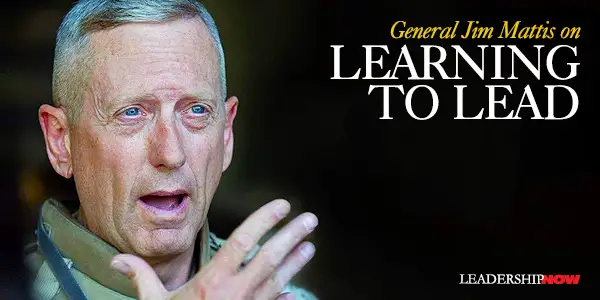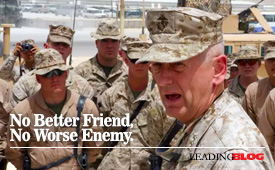General Jim Mattis on Learning to Lead

IT’S NOT SURPRISING that we learn a lot about character from the military. Good character is mission-critical. Under extreme circumstances, if you don’t have good character, the result is extremely bad consequences. In war, character is not a platitude.
Good character development is evident in Call Sign Chaos. Written by Jim Mattis and made better with the help of Bing West, the book details the lessons Mattis learned from more than 40 years in the Marine Corps. He organizes the book in terms of the changing nature of his leadership responsibilities as he moved up the ranks. First, he learned face-to-face or direct leadership. At a time when, “alongside those I led, I had a personal, often intense bond with troops I frequently knew better than my own brothers.”
Next, he discusses executive leadership, where commanding a force of 7,000 to 42,000 troops, it was impossible to know them all individually, so communications and leadership styles must adapt.
Finally, he covers the challenges and techniques relevant to strategic leadership from a senior military officer’s perspective.
(His call sign, CHAOS, was given to him by his operations officer, John Toolan.” It stands for, “Does the Colonel Have Another Outstanding Solution?” “There’s always a Toolan, “he writes, “waiting out there to keep your ego in check, providing you keep the risk-takers and mavericks at your side.”)
As is commonly done, a book is a good place to settle scores and vent your opinions. Although Mattis resigned halfway through his appointment as Secretary of Defense at the end of 2018, he writes, “I’m old-fashioned: I don’t write about sitting presidents.” “Old-fashioned” is often another way of saying character.
Importantly, he talks about the challenge of communicating the commander’s intent. When commanding a large number of troops or a large organization, a leader must be able to communicate their intent in such a way as to allow people to act. It requires discipline and trust.
Developing a culture of operating from commander’s intent demanded a higher level of unit discipline and self-discipline than issuing voluminous, detailed instructions.
In drafting my intent, I learned to provide only what is necessary to achieve a clearly defined end-state: tell your team the purpose of the operation, giving no more than the essential details of how you intend to achieve the mission, and then clearly state your goal or end state, one that enables what you intend to do next. Leave the “how” to your subordinates, who must be trained and rewarded for exercising initiative, taking advantage of opportunities and problems as they arise.
It highlights the need for clear and consistently enforced values to guide teams and organizations. Commander’s intent provides a framework that everyone can operate from.
Mattis also mentions the need to get inside the enemy’s OODA loop—to adapt faster than they could. The OODA loop is a concept developed by Colonel John Boyd and stands for observe–orient–decide–act. In uncertain and changing environments, one can gain the advantage if they can ensure that their OODA loops are functioning, as Mattis puts it, “at the speed of relevance. It is possible then, to get inside the enemy’s OODA loop. This is made possible, in part, by having the commander’s intent clearly communicated and understood. The OODA loop helps us to shift our perspective from what we want things to be to what they are in reality. A common organizational problem.
Our campaign’s success was based on not giving the enemy time to react. To win a dogfight, Boyd wrote, you have to observe what is going on, orient yourself, decide what to do, and act before your opponent has completed his version of that same process, repeating and repeating this loop faster than your foe.
Call Sign Chaos has actionable ideas throughout for any team. What follows are quotes taken from the book that will give you a flavor for what is addressed here:
The Marine philosophy is to recruit for attitude and train for skills. Marines believe that attitude is a weapon system.
I was taught to use the concept of “command and feedback.” You don’t control your subordinate commanders’ every move; you clearly state your intent and unleash their initiative. Based on feedback, you fix the problem. George Washington, leading a revolutionary army, followed a “listen, learn, and help, then lead,” sequence.
I matched personalities to anticipated tasks.
I’ve found this imagining technique—walking through what lies ahead, acclimating hearts and minds to the unexpected—an essential leadership tool.
Once he’s removed from direct interaction with his troops, a commander must guard most rigorously against overcontrol, compounded by the seduction of immediate communications.
If you can’t talk freely with the most junior members of your organization, then you’ve lost touch.
When you are in command, there is always the next decision waiting to be made. You don’t have time to pace back and forth like Hamlet, zigzagging one way and the other. You do your best and live with the consequences. A commander has to compartmentalize his emotions and remain focused on the mission. You must decide, act, and move on.
I don’t care how operationally brilliant you are; if you can’t create harmony—vicious harmony—on the battlefield, based on trust across different military services, foreign allied militaries, and diplomatic lines, you need to go home, because your leadership is obsolete.
In an age when cynicism too often passes for critical thinking, it’s worthwhile to remember that young men and women who sign up for the military still fight for ideals.
When things go wrong, a leader must stand by those who made the decision under extreme pressure and with incomplete information. Initiative and audacity must be supported, whether or not successful.
The more trust there is inside a unit, the more strain that unit can withstand without a lot of discussion.
I’ve always tried to be hard on issues but not on spirits.
A senior leader in any organization must recognize when his environment has changed.
If there’s something you don’t want people to see, you ought to reconsider what you’re doing.
A leader’s role is problem solving. If you don’t like problems, stay out of leadership. Smooth sailing teaches nothing
Discipline is our protective fabric.
You cannot allow your passion for excellence to destroy your compassion for them as human beings.
Culture is a way of life shared by a group of people—how they act, what they believe, how they treat one another, and what they value.
At inflection points, as history has made clear, change must come at the speed of relevance. Leaders must shelter those challenging nonconformists and mavericks who make institutions uncomfortable; otherwise, you wash out innovation.
Living in history builds your own shock absorber, because you’ll learn that there are lots of old solutions to new problems. If you haven’t read hundreds of books, learning from others who went before you, you are functionally illiterate—you can’t coach and you can’t lead. History lights the often dark path ahead; even if it’s a dim light, it’s better than none. If you can’t be additive as a leader, you’re just like a potted plant in the corner of a hotel lobby: you look pretty, but you’re not adding substance to the organization’s mission.
Trust is the coin of the realm for creating the harmony, speed, and teamwork to achieve success at the lowest cost. Yet it’s not enough to trust your people; you must be able to convey that trust in a manner that subordinates can sense. Only then can you fully garner the benefits.
Allowing bad processes to stump good people is intolerable.
Leaders at all ranks, but especially at high ranks, must keep in their inner circle people who will unhesitatingly point out when a leader’s personal behavior or decisions are not appropriate. In its own way, this, too, is part of command and feedback, for none of us are infallible.
* * *

Like us on
Instagram and
Facebook for additional leadership and personal development ideas.
* * *




Posted by Michael McKinney at 07:51 AM
Permalink
| Comments (0)
| This post is about Leadership Development










